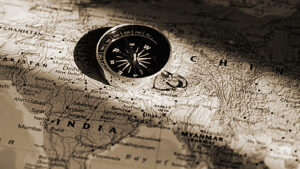Great Game 2.0 and modern-day East India Companies
Ratna and Nadim Siraj
EmpireDiaries.com
January 25, 2024: As India joyfully celebrates Republic Day, let us take a thoughtful step back and look at the country from a wider perspective to understand whether the Indian population is as economically independent as it is politically and administratively. To figure it out, one first needs to understand the real meaning of national independence.
Well, national independence has never been and can never be a binary scenario where you can straightaway conclude that a country is fully independent. Essentially, there are two kinds of independence a nation can experience – political and administrative independence and economic independence.
Political independence, or political-administrative-diplomatic independence, is the kind of freedom that allows the citizens of a country to elect their own political leaders. In a politically independent nation, the judiciary, the army, the police, the administrative class, the technocrats, the diplomats, and the influential domestic businesses are all represented by that country’s own citizens, not by foreign nationals.
But crucially, being politically independent is not enough for a country’s population to experience real freedom. There are many countries in the world that are currently experiencing political freedom, but don’t have economic independence.
The economy – which is the heart and heartbeat of any country – lies beyond the control of the citizens of such nations. In these countries, the domestic economy is controlled, or influenced, or manipulated by foreign corporate forces. Therefore, a politically independent nation is not free from foreign control if overseas powers control its economy and inflict a constant economic drain.
Economic independence is the kind of freedom that gives a country’s citizens genuine and full-spectrum freedom, ranging from a complete say in domestic politics to total control over the domestic economy. An economically independent nation is both politically free as well as economically free. No foreign corporate powers intervene in any affairs of that country, be it in the economy or elsewhere.
Elephant in the room
So, seven and a half decades since breaking free from rogue and uncivilised British invaders who devastated the Indian subcontinent for over two centuries, where does India stand today? What kind of independence do Indians experience? Has this nation tasted full-fledged economic freedom, or are we Indians only politically independent?
The bitter truth that the mainstream media, schools and colleges, universities, intelligentsia, historians, activist groups, celebrities, experts, and people in power don’t tell the Indian public is that this country of 1.44 billion people is independent only on the political-diplomatic-administrative front.
For about the last three decades right up to this Republic Day, India actually hasn’t quite experienced full-fledged independence, that is, or economic independence. The country’s vast and lucrative economy is being pursued by foreign powers as part of a modern-day Great Game. At Empire Diaries, we call it Great Game 2.0.
Incredible and conspiratorial as it may sound, the truth is that the country’s economy is now largely in the hands of foreign corporate forces, which are headquartered in faraway countries. These foreign corporate players, or ‘modern-day empires’, are a gigantic fleet of foreign-headquartered MNCs, conglomerates, and charitable-looking sounding foundations. The international corporations have been dominating India’s economic landscape irrespective of whichever political party has been in power over the last three decades.
These overseas players have offices and operations right inside India and back home as well. They collectively mint a phenomenal amount of money by doing healthy business in this country. Crucially, these foreign corporate powers suck a majority of those earnings out of India and inject them into the economies of their home countries.
In a nutshell, it is an enormous and unreported economic drain that practically no-one talks about. It’s an elephant in the room that everyone seems to pretend it’s not there. And India is not alone at the wrong end of the barrel. There are some other South Asian countries, such as Bangladesh, Nepal, Pakistan, and Sri Lanka. Then there are countries in Africa, Southeast Asia, South America, and eastern Europe.
Modus operandi: Repatriation of profits
As a result of this perpetual economic drain of India’s finances by foreign corporations through what is technically called repatriation of profits, the country is in a perpetual state of increasing poverty and decline. And as a result of India’s financial wealth getting pumped into the economies of the countries where the foreign corporations come from, those countries are perpetually experiencing growing prosperity.
As Indians mark Republic Day, this investigative article digs deep into the nuts and bolts of this unreported financial wealth transfer or economic drain from India to abroad, the modus operandi of these modern-day empires, and why the Indian public is never told about this neocolonialism project.
In the world of geopolitics, there’s a term called ‘Great Game’. It refers to the historical race between the British and the Russian empires back in the 19th century to colonise Central Asia. Today, a similar race is underway – it’s a silent race among 17,000-plus foreign companies to recolonise India’s vast marketplace, directly or through subsidiaries.
This ongoing race can aptly be called ‘Great Game 2.0’. It is a neocolonialism project that is taking place on an unprecedented scale, and at an unprecedented speed.
Shocking numbers, then and now
Schoolbooks and historians routinely remind us of how the British, French, and Portuguese East India Companies, and later the British monarchy, colonised the Indian subcontinent once upon a time and squeezed the territory dry.
Much of blame is given to the British East India Company and the rogue Buckimgham Palace, which together robbed and routed the Indian territory during a 190-year-long imperial-style rule from 1757 to 1947.
In 2018, an economic investigation conducted by Indian economist Utsa Patnaik revealed that British invaders stole about $45 trillion from the people of the Indian subcontinent between 1765 and 1938.
However, you will not find any prominent economist, journalist, politician, government body, academician, commentator, or NGO turning the spotlight towards the ongoing recolonisation of the Indian economy by foreign corporate giants – the ongoing loot. There are a few activists and researchers who are trying to educate the public about the ongoing economic drain project, but their voices can only be heard on the fringes of India’s mainstream discussions and debates.
A look at the numbers will give you a clear picture of how deeply the Indian economy is currently colonised by foreign corporate forces.
Back during the official British colonial era, the Britishers used to siphon financial resources out of the subcontinent that was equivalent of 8% of the GDP. Fast forward to a couple of years ago, according to independent research, foreign corporate players collectively transfer financial resources out of the country that is equivalent to 17% of the GDP. Basically, the Indian economy is now twice more colonised than it was during the British era.
The independent researchers concluded that in recent years, foreign corporate players have been pumping out an estimated $500 billion in financial resources from the Indian economic – reinvesting or parking most of that Indian money in their home economies.
Colonialism, then and now
Back during the time when barbaric European pirates illegally colonised the Indian subcontinent, several foreign companies conducted business with the subcontinent and took home the earnings they made here. They were the British East India Company, French East India Company, Portuguese East India Company, Dutch East India Company, Danish East India Company, Swedish East India Company, and Austrian East India Company. They routinely squabbled with one another, but their mission was the same – to make profits here and to take it home.
Compare that to today, instead of a handful foreign companies, there are a mindboggling 3,291 foreign companies that are actively operating in India, along with 14,137 active foreign subsidiaries. A vast majority of these foreign MNCs or modern-day empires descended upon Indian soil during the last 30 years, after India inexplicably opened the doors of the country’s economy during the early 1990s for foreign corporate players to come and exploit. That exploitation of the Indian economy is underway right now, and is showing no signs of slowing down. It’s the undeclared Great Game 2.0.
And where do these thousands of hawkish, India-focused overseas companies come from? Data from the corporate affairs ministry shows that most of these companies are headquartered in the United States, followed by Singapore, Britain, China, Japan, Russia, Germany, Hong Kong, France, South Korea, Switzerland, Netherlands, Canada, UAE, Australia, Spain, Malaysia, Taiwan, and a few other countries and territories.
Interestingly, these overseas business entities don’t necessarily push their case themselves all the time. There is a network of international bodies and groupings that often lobby on their behalf, coaxing the governments of their target countries, such as India, to open up their markets for foreign businesses to explore or exploit.
Some of these international entities, which often use ‘globalisation’ and ‘free trade’ as their buzzwords in what they do, include the United Nations (UN), World Economic Forum (WEF), World Health Organisation (WHO), North Atlantic Treaty Organisation (NATO), World Trade Organisation (WTO), Organisation of the Petroleum Exporting Countries (OPEC), European Union (EU), Group of Seven (G7), World Wide Fund for Nature (WWF), Organisation for Economic Cooperation and Development (OECD), Asian Development Bank, World Bank, and International Monetary Fund (IMF).
In this Great Game 2.0, what are the forms and shapes in which these foreign companies operate in India, and how do they transfer their profits out of the country? Some of them go about their business on Indian soil directly operating as parent companies, using liaison offices and project offices. Some of them operate here through branch offices, while some others are present here through wholly owned subsidiary companies.
The official presence apart, there are numerous influential foreign companies that do business in India using shell companies, as a cover or a decoy. It means, these companies informally or covertly operate in the country behind the cover of domestic companies, hiding their presence in the Indian marketplace.
Apart from using shell companies to covertly do business in India, many foreign companies and foreign financial investors (or capitalists or funders) also use domestic shareholders and domestic investors as puppet stakeholders in various Indian businesses.
As a result, it becomes virtually impossible to track their presence and operations in the country, which is the whole purpose of going covert. The system is designed that way. That’s how silent neocolonialism works – it’s insulated. The economic drain isn’t easy to bust.
What happens to all the money?
All these companies suck out the earnings they make from their operations in India by various means, such as through dividends or profits, buyback of shares, reduction of share capital, fees for technical services, consultancy services, business support services, and royalties.
In the process, the foreign companies are made to negotiate with multiple regulatory bodies in India, such as those dealing with the Companies Act, Foreign Exchange Management Act (FEMA), tax regulations, double tax avoidance agreements, and transfer pricing rules.
As we mark Republic Day, It is worth noting that these thousands of companies don’t necessarily work together as part of a larger well-oiled cabal. Some of them do coordinate and cooperate as they conduct business here, peacefully carving up the country’s economic landscape into well-marked jurisdictions and zones.
It’s quite like the territorial markings that wild animals do to establish their ‘zones’. And then, there are many other foreign companies that are in a constant state of business war and territorial tussle with each other amid a cut-throat fight for expanding their share of the lucrative Indian marketplace.
Interestingly, while we are never directly told that such a major economic drain project is underway, we are allowed to discuss and debate the collateral impact of the operation, albeit as unconnected dots. Such as rising inflation, deepening poverty, increasing job losses and unemployment rate, alarming rural distress, currency depreciation, expanding slums, infrastructure failures, and perpetual finance crunch at the administrative level.
We Indians do culture on these economic ailments from time to time, but we fail to connect the dots. We don’t realise that they are a collective fallout of the recolonisation of the country’s economy by foreign players.
Role of mainstream media
Unfortunately, for dedicated followers and fanatics of mainstream news, India’s popular press doesn’t make any effort to blow the whistle on this economic drain. Instead, the mainstream media helps those behind the foreign neocolonialism project by keeping the Indian public distracted with shallow and irrelevant news.
They report the fallout of this ongoing neocolonialism as naïve, unconnected events. Hence, people are unable to see the larger picture. Why does the mainstream media play this negative role? It’s because they are on their side, not on the Indian public’s side. All the prominent mainstream media outlets survive on the money they get from the colonising foreign corporate players in the form of advertisements, advertorials, tie-ups, endowments, gifts, and through the ownership of stakes.
If the press survives on ad money from foreign corporations, on ad money from foreign-supported political parties, and on financial support from foreign NGOs, will journalists be in a position to independently open their mouths about the recapture of our economy? No way.
The point is, the dark days of the British East India Company and the subsequent British Raj are here again. The East India Company left us long back, soon after the uprising of 1857. The British monarchy also left us after 1950. But the foreign-meddling is back. Modern-day ‘East India Companies’ now have their boots on the ground. Yet again.
Colonialism didn’t go away for good. It has come back as neocolonialism. It was a case of overt colonisation back then. What is unfolding now is covert recolonisation. Only the pages of the calendar and colonisers’ modus operandi have changed.
One mission, two routes
In the Great Game 2.0, the modus operandi of the modern-day empires targeting India’s vast financial resources comprises two distinct lines of action. One, these companies are soaking money out of India through the WTO-approved practice of international trade.
The WTO or the World Trade Organisation is the international body that the owners of these powerful foreign companies once upon a time lobbied to set up. Why? Because the WTO gives legitimacy to their neocolonialism projects of dumping nonessential goods and services in brand-fanatic countries around the world in exchange for massive profits.
So, one-sided international trade, the terms of which are dictated using diplomatic muscle power, is one prominent way in which foreign companies are transferring money out of India. Here’s a detailed report on this subject from Empire Diaries.
The other way in which India is leaking huge volumes of money and suffering an unprecedented economic drain is through the practice and impact of FDI or foreign direct investment. Under this system, foreign companies have been investing heavily in India’s economy by bringing in their own money as well as by investing loans drawn locally from Indian banks.
After the initial phase, once their businesses started succeeding, they started transferring their earnings or profits straight to their home countries. The money first usually goes into the banks of their home countries. Those banks then reinvest that money into their local economies, subsequently helping the countries prosper, develop, and become economically sound.
As a net effect of this economic drain or financial wealth transfer out of India, the home countries of the foreign corporate forces are getting richer and richer, while they are constantly offloading their poverty right into India. It’s not rocket science. It’s simple economics. But economists with formal education won’t tell you that!
Why else do you think the G7 countries, along with China, South Korea, and a handful of European nations are so opulent? It’s only because modern-day empires from those countries are soaking up immense volumes of money from India, Pakistan, Nepal, Sri Lanka, Bangladesh, the African countries, parts of South America, Southeast Asia, and eastern Europe.
The foreign corporate players behind this enormous economic drain operation to wring India’s economy dry are names that you know extremely well. They are conglomerates, companies, and trusts whose catchy brands are household names across India. They are immensely popular and command blind fanaticism, thanks to the power of year-round ad campaigns.
The idea here is not to name and shame the new ‘East India Companies’ or to whip up xenophobia against foreign cultures, foreign brands, and foreign individuals. Empire Diaries is firmly against xenophobia and believes in the need to exchange cultures and ideas across borders as freely as possible.
The point is, we believe in wholeheartedly supporting local and decentralised businesses over nonessential foreign brands. Why rely on foreign companies, and why make foreign countries rich if we can jolly well buy what we want from our own homegrown businesses?
Most importantly, the exchange, whether economic or otherwise, should be two-way. It should not be one-sided, like it is right now.
The focus of this article is to give you a clear picture that the silent economic drain of the Indian economy is indeed underway under the garb of ‘globalisation’, and that nobody is paying attention or raising alarm about this intensifying neocolonialism mission. The focus here is to educate fellow Indians that the country will become poorer and poorer if this gigantic wealth transfer is allowed to continue freely.
Today, look at any industry, and you will find that foreign corporate players are basically running the show. In some sectors of the Indian economy, the foreign players have moderate influence, such as milk distribution, tobacco, and budget hotels. But in many other areas, they call the shots, dictating terms to the vast Indian consumer base.
Full-spectrum neocolonialism
Fast-food chains, retail outlets, sports goods, mobile phones, smart gadgets, digital entertainment, internet services and platforms, gaming gear, fashionwear and textiles, cold drinks, banks, publishing companies, electronic equipment, hospitals and medicines, cars, insurance, toys, hotel chains, chocolates, passenger planes, fighter jets, arms and ammunition, medicines, hospital services, home delivery networks, payment apps, household essentials – Indian companies are losing out to foreign forces in most of these sectors.
What has been the biggest success of these modern-day empires? By smartly using their influence and charm, and the power of perpetual advertising, they managed to turn millions of Indians into devoted customers and dedicated employees, who have internalised their fanaticism for anything and everything that’s foreign, irrespective of whether they are essential.
You might wonder, what’s wrong if foreign companies are doing business in India? Aren’t they generating jobs? Aren’t they bringing in investment money? Aren’t they paying taxes and offering the Indian public new things to buy, experience, and experiment with? Aren’t they making our shopping malls attractive hangouts for families? Are we wrongfully questioning their presence on Indian soil? Are we too harsh to call their actions neocolonialism?
The bottom line is, their positive contribution to Indian society and the Indian economy is primarily superficial. It is outweighed by the overall deep negative impact of the financial wealth transfer they are carrying out.
It’s quite like flashy CSR events held by tax-evading companies, or well-advertised charity done by controversial billionaires who seek to whitewash their image. The math is plain and simple. The minuses dwarf the pluses. The net result is a constant economic drain. And the mainstream press tells you only about the pluses of the foreign companies’ contribution to India.
To understand what is precisely going on in this economic drain project, let’s use the example of a hugely popular, foreign cold-drink company operating in India. The example case study can be multiplied a few thousand times to get a sense of how we are financially bleeding due to the overall impact of this economic recolonisation.
Soft-drink mathematics
Let’s assume, an American soft-drink is an immensely popular consumer good all over India, especially attracting youngsters, sports junkies, shoppers, and foodies – right from big cities to suburbs to villages. For every bottle of soft drink that the foreign company produces in India and sells here, it makes a certain profit.
Out of that profit earned per bottle, one part goes to the Indian government’s coffers as taxes. Another part is reinvested by the foreign company into its operations in India to expand its business. And the third part of the profit (usually, the largest part) is transferred straight to the home country of the soft-drink company where it is headquartered.
So, a big chunk of the money that the foreign fizzy-drink brand makes in India is sent all the way to a foreign country, the company’s home turf. Technically, the money travels from here to foreign banks, while some of it also gets parked in tax havens around the world.
Now multiply that take-home profit from that one soft-drink bottle by lakhs and lakhs of bottles that the foreign company sells in India every hour, every day, every week, every month, and every year. The final sum of the profits that it transfers to its home country – partly to foreign banks and partly to overseas tax havens – runs into millions of dollars annually.
It’s crucial to understand that India’s economic drain is being carried out primarily using the craft of repatriation of profits. Basically, India is ending up leaking its financial wealth like a sieve, simply because millions of Indians casually agreed, or got persuaded by flashy ads, to consume the nonessential beverage regularly.
That perpetual transfer or outflow of money from the hands of Indian consumers to the coffers of the American soft-drink giant happens on a mass scale, forcing India’s economy to lose its financial wealth. That trend of money drain, in turn, directly contributes to India’s escalating poverty.
Wealth transfer, poverty transfer
Well, because there’s a neat transfer of wealth from India to a foreign country, there’s also a resultant transfer of the same degree of poverty from the recipient country straight into India. Wealth moves from here to there, and poverty gets transferred from there to here. So, as the money flows out, the recipient country gets richer, and the targeted country gets poorer. It is economic drain through classical neocolonialism.
As discussed earlier, the outward wealth transfer by foreign companies is not the only way in which India is constantly leaking money. There’s another way in which moolah flows from here to the banks and economies of foreign countries. It’s through the import of nonessential goods from abroad via international trade. Essentially, India imports much more from other countries than it exports to them, resulting in an overall outward drain of the country’s financial resources.
In December 2023, India’s trade balance ran an embarrassing deficit of $19.8 billion, which means our overall imports overshot our overall exports by a massive margin. Between January 1957 and November 2022, India’s average trade balance stood at a deficit of $401 million.
In the first seven months of the 2023-24 fiscal year, India reported a trade deficit with nine of its top 10 trading partners.
Dependency theory
There’s an interesting theory that explains India’s economic drain well. It’s called the dependency theory, which explores the root cause of why countries such as India perpetually suffer from a trade deficit and finance drain. The dependency theory has its beginnings in two papers that were written in 1949. They were authored by Hans Singer, a German-born economist from the UK, and Raul Prebisch, an economist from Argentina.
According to the theory, some countries remain financially troubled because vital resources always flow from the margins of human civilisation, which are poorer and diplomatically weaker nations, to the core of human civilisation, which are affluent and diplomatically powerful countries.
The dependency theory says that this imbalance caused by powerful countries dominating less influential countries and siphoning their money becomes possible primarily because the two contrasting parties are deeply integrated into a common global system.
As a result of this integration or connectedness, weak countries are unable to break free from the influence or orbit of powerful countries, which then exploit them financially through economic tools such as trade, FDI, and foreign loans.
This Singer-Prebisch theory, as it is also called, helps us understand why India continues to remain so poor – mainly because our economy is too deeply integrated with a rigged world system in which the terms of trade and international law are heavily tilted in favour of powerful countries that call themselves developed nations.
When India was prosperous
Let’s turn the clock back by about 1,000 years to the time when the Indian landmass was not colonised by foreign players. In the year 1000CE, several kingdoms or empires were simultaneously running the Indian subcontinent, having carved out their own respective jurisdictions.
It is estimated that for a 1,000-year period from around 1CE to around 1000CE, the economy of the Indian subcontinent was arguably the largest on the planet. In 1000CE, the Indian peninsular region’s estimated share of the global GDP was as high as 28.9%, which is an incredible figure by today’s standards.
Data estimates show that this region was the most prosperous place on the planet at that time.
Seven centuries later, when the Mughals were in power during the year 1700, the Mughal empire and the Chinese empire of that time were jointly the two biggest economies in the world – each empire or region boasting an impressive 25% share of the global GDP.
However, the Indian subcontinent’s phenomenal prosperity began to drastically diminish when invaders from Europe came along. The biggest dent to the subcontinent’s economy was dealt first by the rogue British East India Company’s 100-year colonial spell from 1757 to 1857; and then by the hawkish British monarchy’s 90-year misrule from 1857 to 1947.
By the time India eventually gained political freedom from British invaders in 1947, its share of the global GDP stood at a pathetic 3% – a sad outcome of European colonisation. As of 2023, India’s share of the global GDP was 7.51% – which is well below the bright days of the past.
In simple words, India has today been reduced to a gigantic and profitable marketplace and a cheap-labour destination. From the standpoint of opportunist foreign countries, this land is a dustbowl teeming with hordes of consumers, and plenty of cheap and skilled workers.
Great Game 2.0: Trail of destruction
In this context of the economic drain, let’s look back at the gigantic shock treatment that Indians received about 30 years ago. We’re talking about the liberalisation, privatisation and globalisation of the Indian economy that was kick-started in the early 1990s.
Data shows that the unemployment rate in India in 1991 was 5.45%, but 22 years after the much-celebrated economic reforms, joblessness jumped up to 8.5%. The trend has been equally dismal for youth unemployment as well. The youth unemployment rate was 16.6% in 1991. In the next 28 years, it shot up to 23.34% in 2019.
The data on India’s rising income equality is also alarming. In January 2020, Oxfam published a disturbing study. It concluded: “India’s richest 1% owns over four times the wealth owned by 953 million people who make up for the bottom 70% of the population.”
These tell-tale numbers prove that the celebrated entry of foreign corporate players into the Indian marketplace has categorically not resulted in more jobs, and has neither improved the Indian public’s overall financial condition.
Instead, it has denuded the Indian economic landscape by scraping out financial resources. Only a small section of the Indian population experienced genuine prosperity since foreign corporations entered India, while the large majority of people have not benefited at all. The income, wealth, and well-being divide is widening.
The writing is on the wall. If a country decides to allow foreign forces to pump money out of the economy, the result is a foregone conclusion. It’s the same story across the economically targeted world – the rest of South Asia, Southeast Asia, Africa, South America, and parts of Eastern Europe.
The narrative war
A major factor that played a crucial role in misleading the unsuspecting Indian public into welcoming the onrush of foreign corporate players was the crafty use of deceptive terminology. It is a necessary hallmark of economic drain through neocolonialism.
Just as foreign corporations were making a beeline to enter India, the mass media – some unwittingly and some knowingly – began to dish out certain strategic terms through their headlines and daily news coverage.
The term ‘FDI’ serves as a naïve cover for what is actually an economic invasion by foreign forces using foreign capital. ‘Privatisation’ is a cosmetic term for the forced sale of state-owned assets to domestic and foreign companies.
There is nothing free about ‘free trade’ because it actually means big companies from powerful countries can dump their nonessential goods in India in exchange for big bucks (remember the dependency theory discussed earlier?).
There’s more. The term ‘globalisation’ is tactically sold to the public to make them fall in love with foreign brands rolled out by giant MNCs, whose products and services are grossly overpriced, over-advertised, and often nonessential. And the term ‘liberalisation’ helps remove government-led measures in place to protect frail domestic businesses from being swept aside by robust, invasive foreign monopolies.
This brand of post-1947 economic drain of the Indian economy has its roots in the 1940s. It actually began with the birth of the World Bank, the IMF, and the General Agreement on Tariffs and Trade (GATT), which later became the WTO.
Fast forward to the present. We are seeing yet another level of the recolonisation of India driven by the so-called AI revolution, mobile-phone penetration, and a war on cash.
The explosion of the internet, the invasion of mobile phones as ‘smart’ devices, the social media boom, and the sharp rise in app-based, non-cash services are collectively a case of modern-day tech empires, mostly from California’s Silicon Valley, capturing India’s digital landscape.
If you take a step back and look at India’s internet ecosystem, you will realise that foreign tech giants literally own the online space. From social media apps to internet browsers to video-sharing sites to OTT platforms to ecommerce services to smart devices – Indians are deeply and excessively dependent on tech empires from California.
Catch this special report from Empire Diaries for more details on how Californian corporate empires are running our lives.
Great Game 2.0: Will India survive?
Companies, corporations, MNCs, transnational companies, conglomerates, enterprises, trusts, venture capitalists, angel investors, seed funders, endowments, startup-funding platforms, philanthrocapitalist networks, trade bodies, etc. – by whatever name you call them, they are the modern-day ‘East India Companies’. And yet again, it’s India that is in their crosshairs as part of their neocolonialism mission to make money. Because they see India as a lucrative market. A market that can help them prosper at the expense of the Indian public’s financial security and well-being.
There’s an old saying – desperate situations need desperate measures. For Indians, nationalistic occasions such as Republic Day remind us that we are indeed capable of setting our economy free from foreign control, and therefore, plug the economic drain.
If our freedom fighters could do it valiantly in the past, the same effort can be replicated again. And to achieve that, we don’t need guns, bullets, military wars, violence, extraordinary infrastructure, and xenophobic measures against foreign cultures.
All we need to do is to simply wake up to this neocolonial loot, and reset our mindset.
First of all, we need to sweep aside our obsession with domestic politics, and start looking beyond it to understand how our world works. We first need to know that we don’t know.
Next, we need to make a collective decision to start helping thousands and thousands of domestic businesses – picking the honest and non-monopolistic ones – to stand up on their feet. If we start prioritising the products and services offered by domestic companies, then they can steadily begin to outperform their foreign rivals operating on Indian soil.
Such a constructive, peaceful, and economically sensible movement will ensure that the reins of India’s economy will return to the hands of domestic businesses – big, medium, and small. If domestic businesses start flourishing, they will have a tendency to reinvest most of their profits back into the Indian economy – as opposed to the current case of foreign companies transferring most of their profits out of the Indian economy.
The resultant pause in the outward drain of India’s financial resources will directly lead to authentic economic self-sufficiency, growth, and development across the country, accompanied by rising prosperity across income groups.
This idea isn’t a fairytale or a myth. That’s precisely how the Indian subcontinent actually was about 1,000 years ago before European pirates arrived. And that’s precisely how the world’s richest dozen countries are right now.
(Image credit: Tyler Quiring, Unsplash)
COPYRIGHT & REPUBLISHING TERMS:
All rights to this content are reserved with Empire Diaries. If you want to republish this content in any form, in part or in full, please contact us at writetoempirediaries@gmail.com.












Hi, good post. Your website appears to have an issue with Internet Explorer. This problem will cause a lot of people to miss your good content because IE is still the most common browser.
Wow amazing blog layout How long have you been blogging for you made blogging look easy The overall look of your web site is magnificent as well as the content
I do believe all the ideas youve presented for your post They are really convincing and will certainly work Nonetheless the posts are too short for novices May just you please lengthen them a little from subsequent time Thanks for the post
A long and interesting article. My issue is with the quality of Indian produce, not much of which match up to international standards. Our patent position us weak, because of almost nonexistent R&D and we love earn money more than respect. Not one Indian brand is known internationally. If we want the domestic economy to soar, we must export quality. We will not survive in isolation. But your points are well put. Kudos.
Thank you for your feedback! Very interesting point argued. But yes, India’s export quality can be achieved once the first blows are dealt to the neocolonialist forces. A possible scenario where things will eventually fall into place, only when the first baby steps are taken. Unfortunately, the Indian leadership, political and administrative, is too compromised or uninformed about how to go about taking the bull by the horns.
1. foreign corporate players collectively transfer financial resources out of the country that is equivalent to 17% of the GDP
2. foreign corporate players have been pumping out an estimated $500 billion in financial resources from the Indian economic – reinvesting or parking most of that Indian money in their home economies.
can you please provide links to researches which concluded above statements?
Thank you for writing in. Our data comes from our first-hand, backend network of seasoned researchers who’ve dug it up as their original research. The figures, even though estimates, are broadly genuine. Unfortunately, the truth is never something that the authorities and the mainstream media will spoon-feed you via easily available links and PR rollouts! As the old saying goes, if something’s readily available online, it’s usually propaganda! Keep tracking and sharing our original work. Cheers.